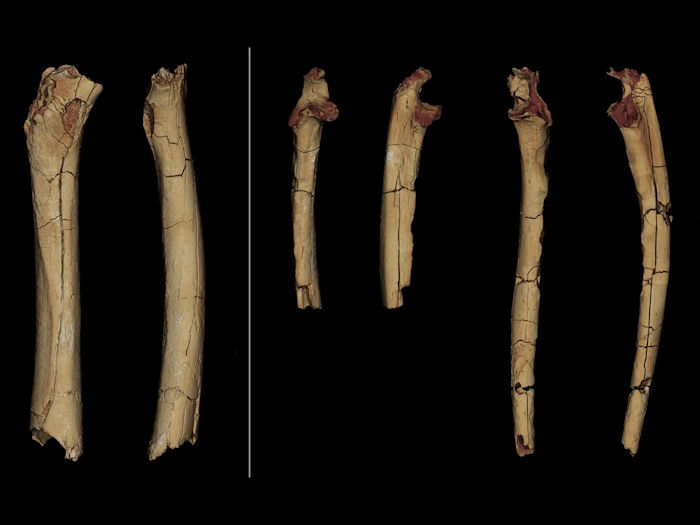Early Humans Were Walking 7 Million Years Ago – Hominin Fossils Reveal
Jan Bartek - AncientPages.com - Hominin fossils discovered at the Toros-Menalla site in Chad’s Djurab desert have substantially contributed to scientists’ understanding of early human evolution in Africa.
According to a new study published in Nature, the fossilized find suggests that early humans regularly walked on two feet some seven million years ago. “The Toros-Ménalla femur exhibits several hallmarks of selection for bipedalism as a regular behavior,” the scientists stated in their study.
Sahelanthropus likely walked on the ground and used all its limbs to move around in trees. Sabine Riffaut, Guillaume Daver, Franck Guy / Palevoprim / CNRS – Université de Poitiers
“Sahelanthropus tchadensis is one of the oldest known species in the human family tree. This species lived sometime between 7 and 6 million years ago in West-Central Africa (Chad). Walking upright may have helped this species survive in diverse habitats, including forests and grasslands.” 1
According to scientists, “the first early humans, or hominins, diverged from apes sometime between 6 and 7 million years ago in Africa. Sahelanthropus tchadensis has two defining human anatomical traits: 1) small canine teeth, and 2) walking upright on two legs instead of on four legs.” 1
It should be added that not all scientists have been convinced these hominins were able to walk on two legs.
The recent study of the fossils belonging to the Sahelanthropus will shed new light on the bipedalism of the species.
The hominins lived during a period when humans branched off to evolve separately from the apes, which is why the species is of great importance to scientists studying evolution.
“In most respects it looks like an ape,” said Daniel Lieberman, a Harvard University paleoanthropologist who wasn’t involved in the new study. The species sported a brain smaller than a chimp’s and an elongated skull with prominent brow. “But it’s got some really key features that make it look like it’s on the human lineage. The most important of those features is that it looks like a biped,” adds Lieberman, who specializes in the evolution of human physical activity.
In the study, the “ulnae and femur from Chad were compared to extant and extinct hominoid specimens, including extant apes (humans, common and bonobo chimpanzees, gorillas and orangutans), Miocene apes and fossil hominins representing O. tugenensis, australopiths and early Homo. Priority was given to wild caught and non-pathological animals when gathering extant specimens.” 2
The results of the study are open to interpretation, some scientists argue, and there are also experts who maintain that the species is a hominin at all.
“The two teams who have collected data from the femur seem to disagree entirely about what the femur shows,” John Hawks, who studies human evolution at the University of Wisconsin–Madison says. “They’re looking at the same piece of bone. I don’t understand how they disagree about this. If either group could just release (surface 3-D and internal CT scan) data so that we can all examine it, there would be no reason for this disagreement.”
“If Sahelanthropus was habitually bipedal, the study’s further analysis of the ulnae, the larger of the two forearm bones which stretches from the elbow to the little finger, shows that its arms were extremely apelike, akin to chimps. So the species was also very competent in the trees,” the Smithsonian Magazine reports.
“I delight in the analysis of the ulnas and the demonstration that Sahelanthropus also lived or moved habitually in the trees,” adds Rick Potts, director of Smithsonian’s Human Origins Program. This evidence suggests, Potts notes, that hominins might have been adapted to move both habitually bipedally and in the trees for almost four million years, from the time of Sahelanthropus to A. afarensis, which showed such adaptations up until about three million years ago.
These 3-D models of the bones of Sahelanthropus show the femur in posterior and medial view (left) and the right and left ulnae in anterior and lateral view (right). Franck Guy / PALEVOPRIM / CNRS – University of Poitiers
As reported by Smithsonian Magazine “naturally, any debate over bipedalism is just one part of a larger and still more intriguing question; is Sahelanthropus really the oldest known member of our human lineage?
Because Sahelanthropus lived so close to the divergence between hominins and apes, scientists debate whether the fossils are from an individual who lived after that divergence, or perhaps one who lived just before the divergence. If the latter, Sahelanthropus could be an ancestor of either chimps or humans, or some common ancestor to both lineages, or even a close relative which is actually ancestral to neither.”
The study was published in Nature
Written by Jan Bartek - AncientPages.com Staff Writer
Expand for references- Sahelanthropus tchadensis - Smithsonian Institution
- Daver, G., Guy, F., Mackaye, H.T. et al.Postcranial evidence of late Miocene hominin bipedalism in Chad. Nature609, 94–100 (2022). https://doi.org/10.1038/s41586-022-04901-z






















